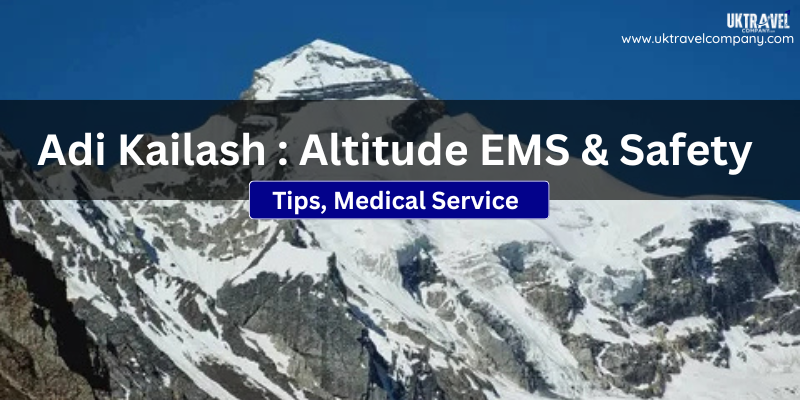Table of Contents
Introduction
Adi Kailash, also known as Chhota Kailash, rises in Uttarakhand’s Himalayas, close to the Indo Tibetan boundary, and is considered highly sacred. Known for its spiritual significance and breathtaking landscapes, this trek attracts both pilgrims and adventure seekers. However, the high altitude and challenging terrain demand preparation. In this guide, we’ll cover the altitude of Adi Kailash, Emergency Medical Services (EMS), and essential safety tips to ensure a safe and memorable journey.
Adi Kailash Yatra Altitude & Location
Adi Kailash is located in the Pithoragarh district of Uttarakhand, near the Om Parvat.
| Details | Information |
|---|---|
| Altitude of Adi Kailash | 6,310 meters (20,700 ft) above sea level |
| Base Camp Altitude (Dharchula) | 940 meters |
| Trek Highest Point (Jyolingkong) | 4,572 meters (15,000 ft) |
| Region | Kumaon Himalayas, near Indo-Tibet border |
| Best Time to Visit | May, June & September, October |
📌 Note: While the peak itself is not climbed (sacred), trekkers reach Jyolingkong village, where you get the divine darshan of Adi Kailash along with a sacred lake and temple.
Emergency Medical Services (EMS) in Adi Kailash Trek
High-altitude treks always come with risks like AMS (Acute Mountain Sickness), injuries, or sudden weather changes. Here’s what you should know about EMS in the Adi Kailash region:
| EMS Aspect | Details |
|---|---|
| Medical Facilities | Basic health check-up at Dharchula; limited at Gunji & Kalapani |
| Ambulance Services | Limited road ambulance till Dharchula; further evacuation is manual/animal-based |
| Helicopter Evacuation | Available in emergencies but costly; depends on weather clearance |
| Local Support | In case of emergencies, the Indo-Tibetan Border Police (ITBP) along with local guides provide necessary assistance. |
| First-Aid | Trekkers should carry personal first-aid kits & prescribed medicines |
| Network Coverage | Mobile signals work partially till Dharchula; BSNL works in patches ahead |
⚠️ Always buy travel insurance that covers high-altitude trekking before starting the Adi Kailash journey.
Safety Tips of Adi Kailash Yatra
Trekking in the Himalayas is not just about stamina, it’s about safety & preparation. Below are the most important safety guidelines:
| Safety Tip | What to Do | Why It Matters |
|---|---|---|
| 1. Acclimatization | Spend 1–2 days at intermediate altitudes; follow “climb high, sleep low.” | Prevents altitude sickness and helps the body adjust. |
| 2. Hydration & Nutrition | Drink 3–4 liters daily; eat carbs & proteins; avoid alcohol & smoking. | Keeps energy levels high and avoids dehydration. |
| 3. Layered Clothing | Carry thermal layers, windproof jacket, and rain gear. | Protects from cold winds and sudden temperature drops. |
| 4. Trekking Gear | Use strong boots, trekking poles, and torch/headlamp. | Ensures grip, stability, and safety in rough terrain. |
| 5. Altitude Sickness Precautions | Watch for headache, nausea, breathlessness; descend if severe. | Helps prevent life-threatening AMS/HAPE/HACE. |
| 6. Weather Awareness | Avoid monsoon (landslides) & harsh winter months. | Reduces risk from unpredictable Himalayan conditions. |
| 7. Respect Local Rules | Carry permits, respect monasteries, avoid littering. | Maintains eco-balance and cultural harmony. |
| 8. Hire a Guide | Always trek with licensed local guides. | Provides navigation help and emergency support. |
Where is Adi Kailash Located?
- District: Pithoragarh, Uttarakhand
- Altitude: 5,945 meters (19,505 ft) above sea level
- Nearby Border: Very close to the India-Tibet (China) border
- Base Town: Dharchula (on the banks of River Kali)
Also Read- How to get Permit pass of Adi Kailash yatra
Explore Our Adi Kailash Om Parvat Yatra Packages
Health & Fitness Preparation
Before you attempt Adi Kailash, it’s crucial to be physically & mentally prepared.
| Preparation | Recommendations |
|---|---|
| Fitness Level | Jogging, cycling, or stair climbing 30–40 mins daily. |
| Strength Training | Squats, lunges, core exercises for stamina. |
| Mental Readiness | Meditation, yoga, or breathing exercises. |
| Medical Check-up | if you have medical conditions such as blood pressure, asthma, or heart-related concerns, it’s best to seek medical advice before planning the trip. |
Conclusion for Adi Kailash Yatra Altitude
Adi Kailash is not just a trek it’s a spiritual journey combined with Himalayan adventure. The altitude, challenging paths, and unpredictable weather make it tough, but with the right preparation, safety measures, and respect for local culture, the experience is unforgettable. Whether you go for devotion or exploration, Adi Kailash will leave you with memories for a lifetime.
FAQs for Adi Kailash Yatra Altitude
Q1. What is the altitude of Adi Kailash?
Adi Kailash, also known as Chhota Kailash, reaches an altitude of approximately 6,310 meters (20,700 ft). Trekkers usually reach villages like Jyolingkong, which sits around 4,572 meters (15,000 ft).
Q2. Can I get medical help during the trek?
Yes. Basic health posts exist at Gunji and Dharchula, while ITBP and local guides can assist in emergencies. In extreme cases, helicopter evacuation is possible, depending on weather conditions.
Q3. What safety precautions should I follow?
Acclimatize gradually, stay hydrated, wear layered clothing, carry a first-aid kit and high-calorie snacks, and trek with a local guide for safety.
Q4. What food is recommended for high-altitude trekking?
Carry energy-rich snacks, nuts, dry fruits, carbohydrate-packed foods like biscuits or oats, and hydrating drinks such as ORS or herbal teas. Avoid oily and heavy meals.



